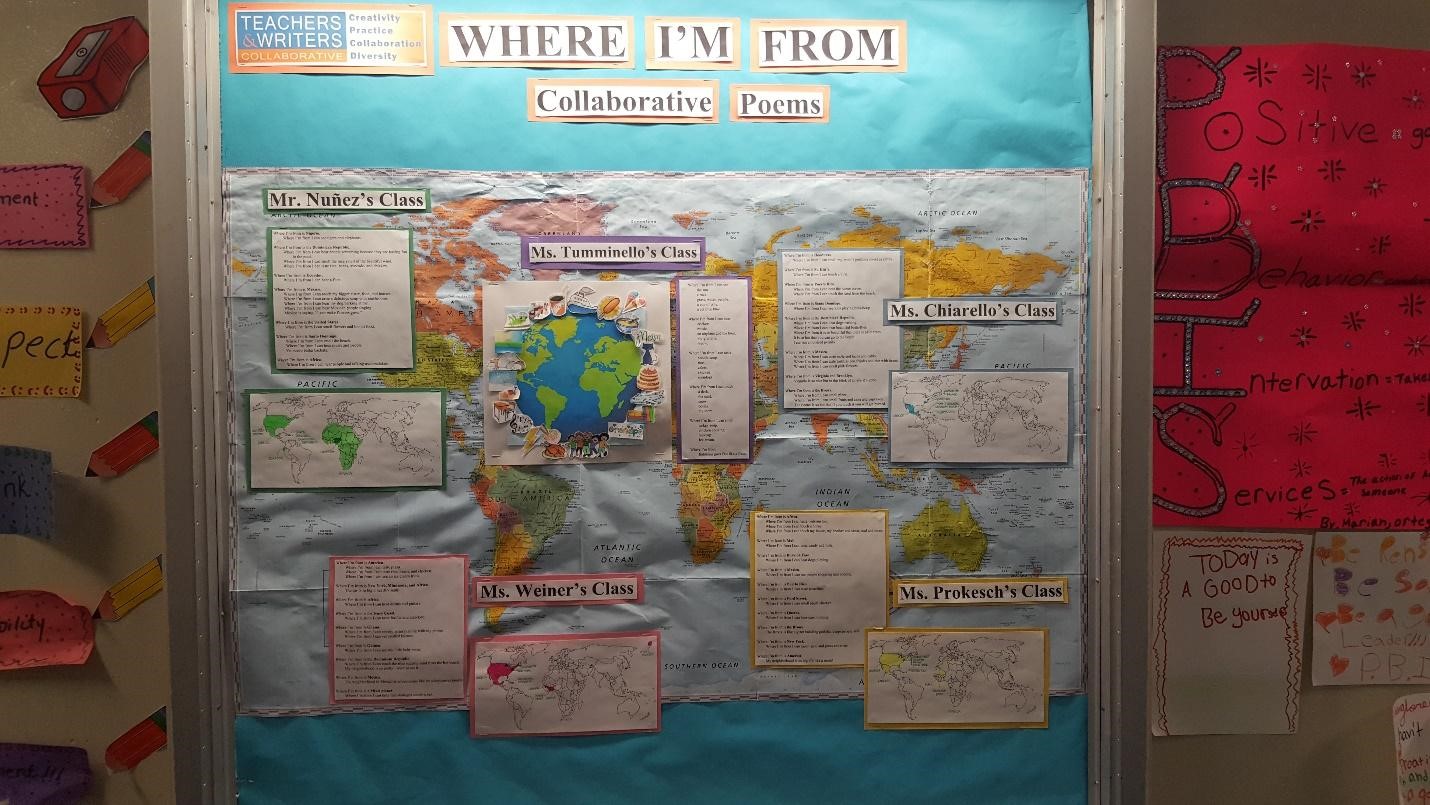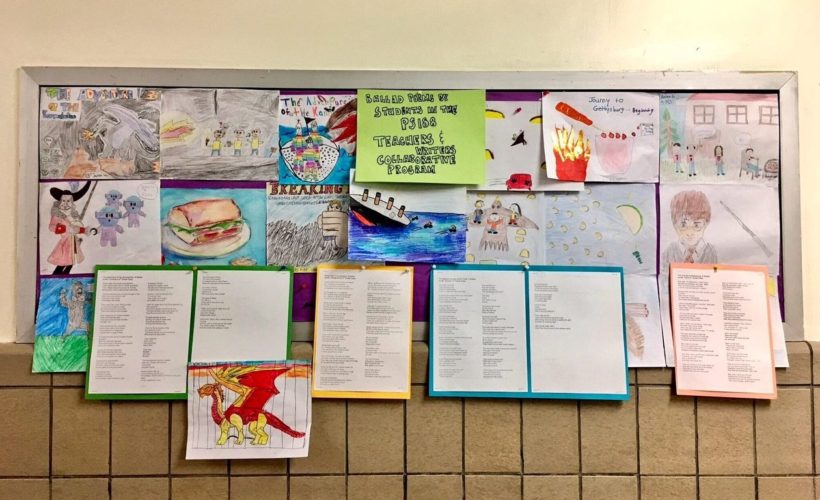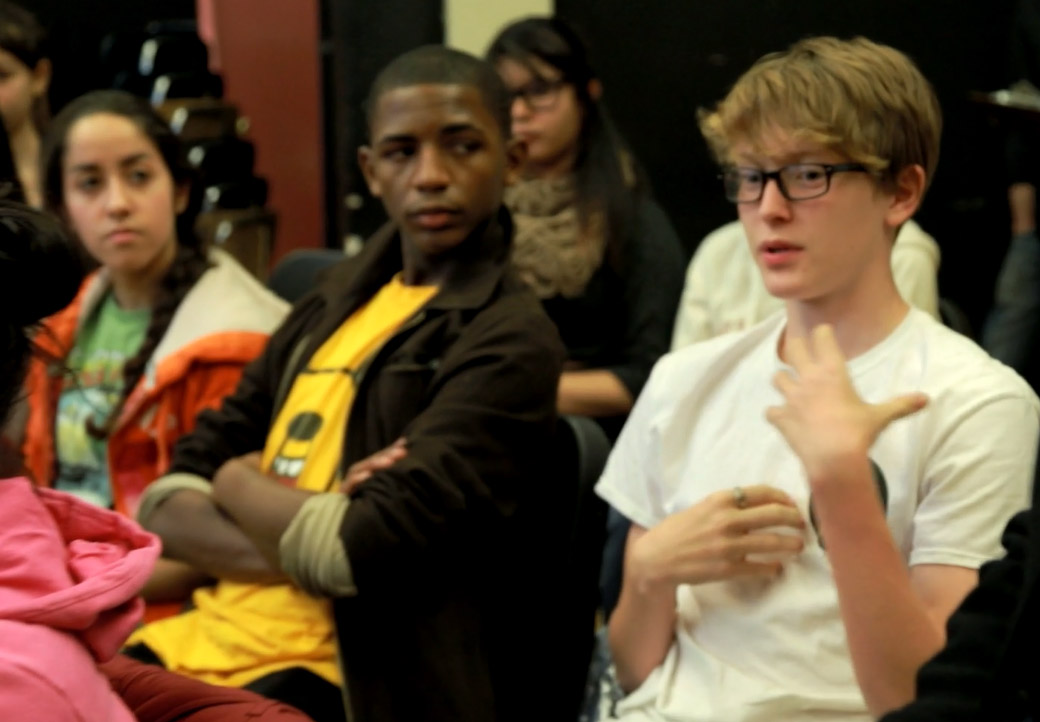T&W teaching artists Alba Delia Hernandez and Samantha LoCoco conducted a 20-session residency at PS 457, Young Leadership Academy, in the Bronx with second-grade gifted and talented students. The students learned about figurative language and poetic structure and examined a range of diverse authors such as Sandra Cisneros, Willie Perdomo, Pablo Neruda, Kwame Dawes, and Langston Hughes.
Teachers & Writers Magazine Editorial Board member Maryana Vestic had an email conversation with Haychel Chiarello, one of the teachers with whom Hernandez and LoCoco collaborated, to learn more about the program’s impact on her and her students.
Teachers & Writers: What was your experience like collaborating with Teachers & Writers Collaborative teaching artists?
Haychel Chiarello: The Teachers & Writers program has been a wonderful experience of self-expression and academic learning for my students and myself as well. The experience has educated me and improved my abilities to teach poetry. Being part of this program has been a pleasure and a tremendous learning experience. I am a better teacher and my students feel like they have become poets.
T&W: What did you find students engaged with the most in the T&W lesson plans, such as the one based on Kwame Dawes’ poem “Tornado Child”?
HC: In terms of the lesson plans, they are not different from the ones we write and execute in class. They followed the same instructional flow as we do. The students were most engaged in the questioning component of the lessons. They loved to answer Ms. Alba’s questions because she never made them feel wrong. They also liked to share their work at the end of each lesson. Even my quiet students, like Jasmin, were willing to share.
T&W: I am very interested in the space left for drawings after the students’ poems on the Dawes’ lesson plan template. Did you find this hindered or assisted the students’ process of writing the poems?
HC: The space left for drawing did not hinder their writing process. The students saw it as an activity they could do at the end of their writing if there was time left. Students gave priority to the writing and saw the drawing as an extension to support their writing. For those students who are not yet independent writers, the drawings did help to make them feel like they could be part of the learning and sharing experience.
T&W: How did the format of the poem template affect the students?
TK: The format of the poem template was a positive strategy for my students because it helped to guide their thinking. The templates helped to keep them focused and inspired them to write from feelings and experiences they have had in their lives.
T&W: I read the poem by your student Jasmin, which was lovely. Did you find that students who had similar backgrounds to Dawes—he immigrated to Jamaica from Ghana while Jasmin came to the US from Mexico—fell into the format of his poem more easily? The way Jasmin meshed the mythological from Dawes’ poem with the everyday in her poem (eating vegetables vs. destroying the world) was very powerful. Do you consider creative writing like Jasmin’s real evidence of success for this program and process?
TK: Creative writing like Jasmin’s is evidence of the success of this program. My students are very connected to their cultures and any educational experience that validates their roots and family traditions validates them and increases their willingness to participate and share their feelings and experiences. Jasmin, like several others, came alive with Ms. Alba and Ms. Samantha and wanted to talk and share.
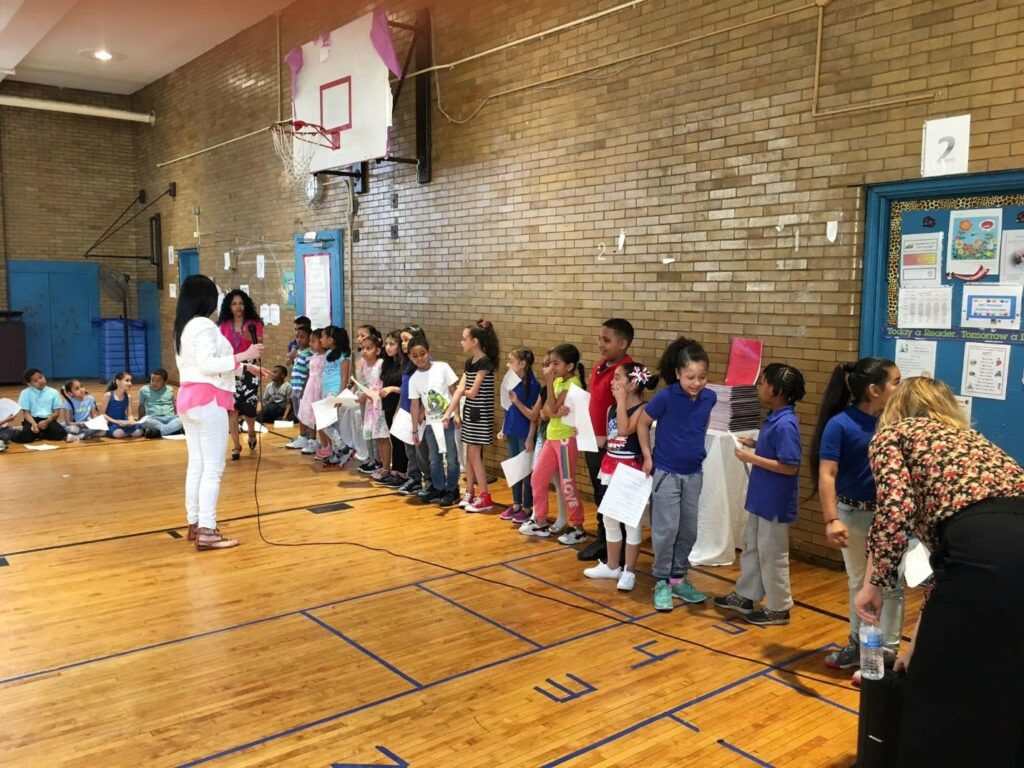
Sample Lesson from PS 457
Grade: 2
Genre: Poetry
Download: Sample Lesson from PS 457
Common Core Standards (Refer to ELA Standards > Writing > Grade 2 and ELA Standards > Speaking & Listening > Grade 2)
- ELA-LITERACY.W.2.5
With guidance and support from adults and peers, focus on a topic and strengthen writing as needed by revising and editing.
- ELA-LITERACY.W.2.8
Recall information from experiences or gather information from provided sources to answer a question.
- ELA-LITERACY.SL.2.2
Recount or describe key ideas or details from a text read aloud or information presented orally or through other media.
Lesson Objectives:
Students will:
- Learn the meaning of “simile” and be able to identify the use of similes in the mentor text.
- Continue to identify metaphors, personification, hyperbole, imagination, and the five senses (sensory language) in their own poems and their classmates’ poetry.
- Write a poem as if they were a force of nature, employing the use of metaphors, similes, personification, and alliteration.
LESSON PLAN
Warm-up:
- Read aloud an excerpt from “Tornado Child,” a poem by Kwame Dawes. Identify when Dawes uses metaphor: “I am a tornado child.” Ask students:
What is the poet comparing? He’s comparing himself to a tornado. How can a tornado and a child be alike? They are fast, powerful, big, strong, angry, etc.
- Identify when Dawes uses simile: “I come like a swirl of black and darken up your day.” Ask students:
What is the poet comparing himself to now? The swirl of a tornado. He uses the word, “like.” What type of metaphor is that? A simile because he used the word, “like.”
- Identify when Dawes uses personification: “if I feel good, I might bring you back, all warm and scared.” Ask students:
Can a tornado “feel good” or be in a good mood? We’re giving a tornado an emotion, just like a human being. What poetic tool is being used?
- Identify when Dawes uses alliteration: “heart humming wild like a bird after early sudden flight.” Ask students:
What beginning sound repeats in this line? What poetic device is being used in the repetition of that sound?
Discussion:
Complete a sample template poem as a class.
- Brainstorm forces of nature or parts of nature to put in the line, “I am a ______________ child.” Examples: sandstorm, wind, hurricane, tsunami, garden, ocean, river, sky, cloud, lightning, thunder.
- Come up with a simile to complete the line, “I come like ________.” Examples: a blinding swirl of dust, a soft-shoed ballet dancer, a pulsing wall of dark blue water.
- Personify the chosen force of nature to complete the following lines:
“If I get mad, I will _______________.” Example: tangle your hair with a million grains of sand
“If I feel good, I will _______________.” Example: lay softly beneath your feet as you dance on the beach
- Repeat the opening line, “I am a ________________ child.” Use alliteration in the final line: “born in _________________.” Example: the whipping winds of way out west.
Main Activity:
Students choose a force of nature from the brainstorm list or another force of their own choosing to begin their poem. Students use the template provided to write their poems. The template prompts the students to use metaphor, simile, personification, repetition, and alliteration.
Review and Closing:
Invite students to share their poems with the class. Support students to apply their presentation and reading skills and to practice offering constructive criticism. Readers will focus on pronunciation, projection, and posture. Listeners will focus on addressing the poet directly to identify the use of one of the five poetic devices: “James, you used personification when you said that the tornado felt happy.” Students are given incentives (e.g., dojo points, stickers) for giving constructive criticism.
Materials:
- SmartBoard or other video projector
- White board markers or chalk to record students’ brainstormed list
- Excerpt from “Tornado Child” to display
- Poem template
Vocabulary: Simile, metaphor, personification, alliteration
Tornado Child (excerpt)
By Kwame DawesI am a tornado child.
I come like a swirl of black and darken up your day;
I whip it all into my womb, lift you and your things,
carry you to where you’ve never been, and maybe,
if I feel good, I might bring you back, all warm and scared,
heart humming wild like a bird after early sudden flight.I am a tornado child
born in the whirl of clouds; the center crumbled
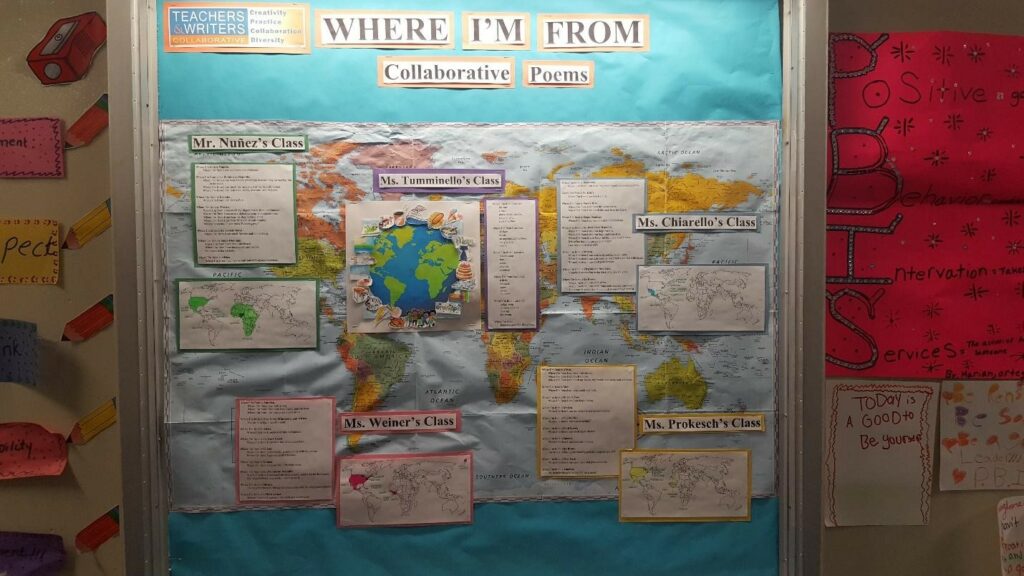
I am a Rising Sun
By Haychel Chiarello, teacher, PS 457I am a Sun Rising child.
I come like a ray of light
through the darkness.
If I get mad, I will walk softly
behind the shield of a cloud.
If I feel good, I will dance from morning
to nightfall in the sky.I am a Sun Rising child,
born in Summer, reborn in Spring.
Tropical Storm Child
By Adam, second-grader, PS 457I am a tropical storm child.
I come like a crazy boar.
If I get mad, I will not let you run or speed walk.
I will push you back.
If I feel good, I will stop pushing you back
and let you walk and run.I am a tropical storm child,
born in depressed Dallas, Texas.
Invisible Child
By Jasmin, second-grader, PS 457I am an invisible child.
I come like smiling.
If I get mad, I will destroy the world.
If I feel good, I will eat vegetables.I am an invisible child,
born in Mexico on May 27.
T&W is grateful to E.H.A. Foundation for making this program possible.
Teachers & Writers Magazine is published by Teachers & Writers Collaborative as a resource for teaching the art of writing to people of all ages. The online magazine presents a wide range of ideas and approaches, as well as lively explorations of T&W’s mission to celebrate the imagination and create greater equity in and through the literary arts.

